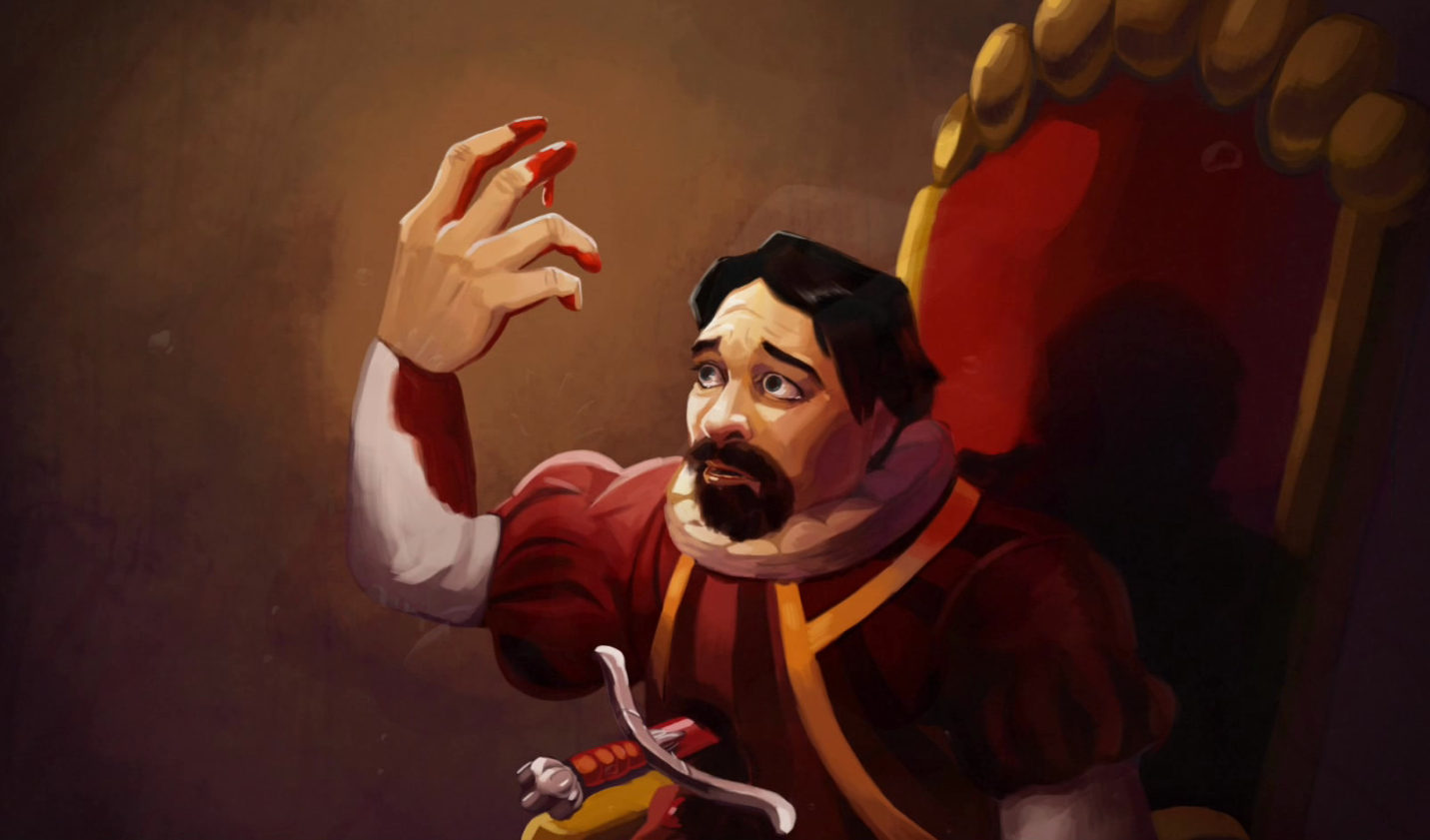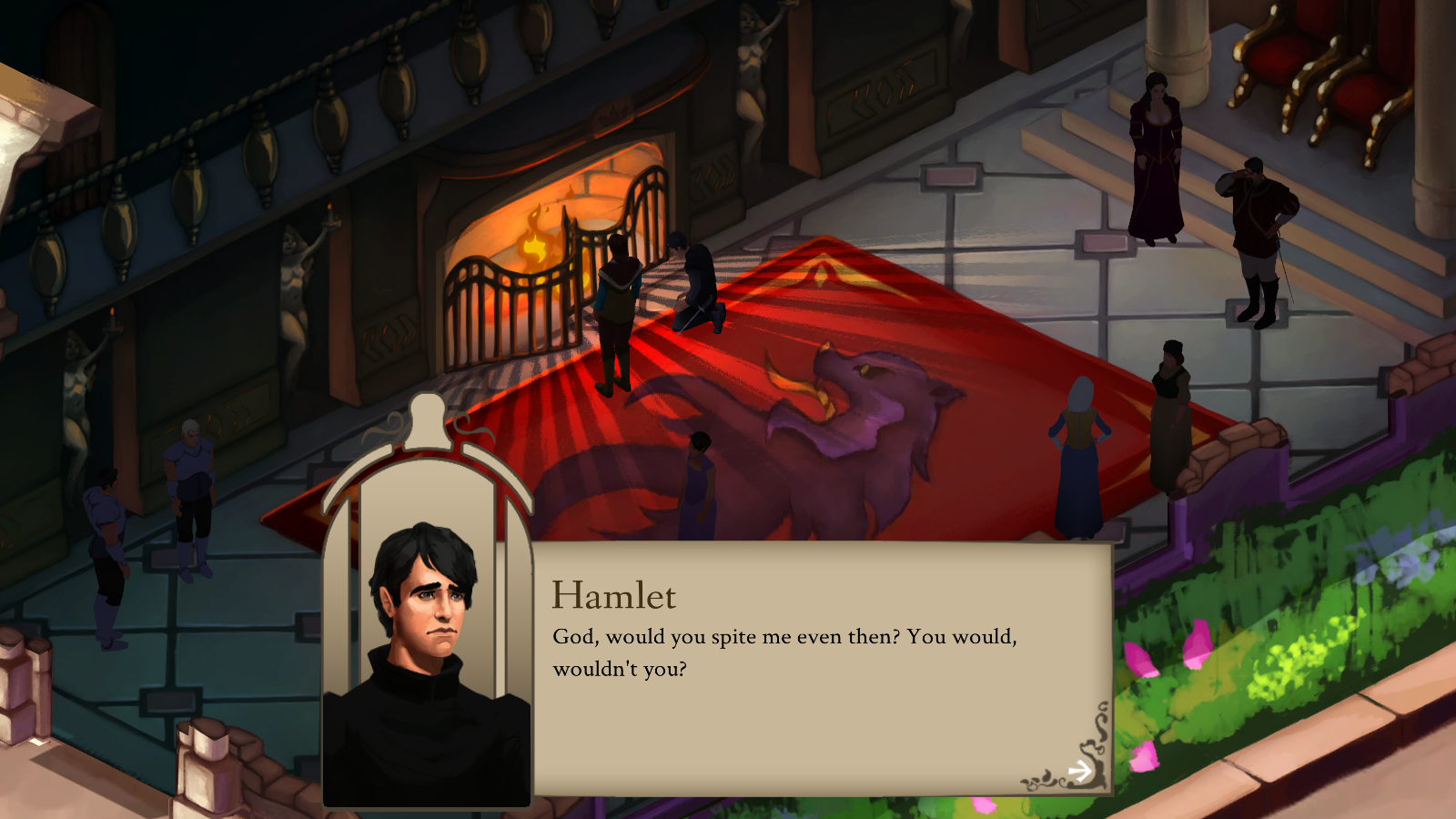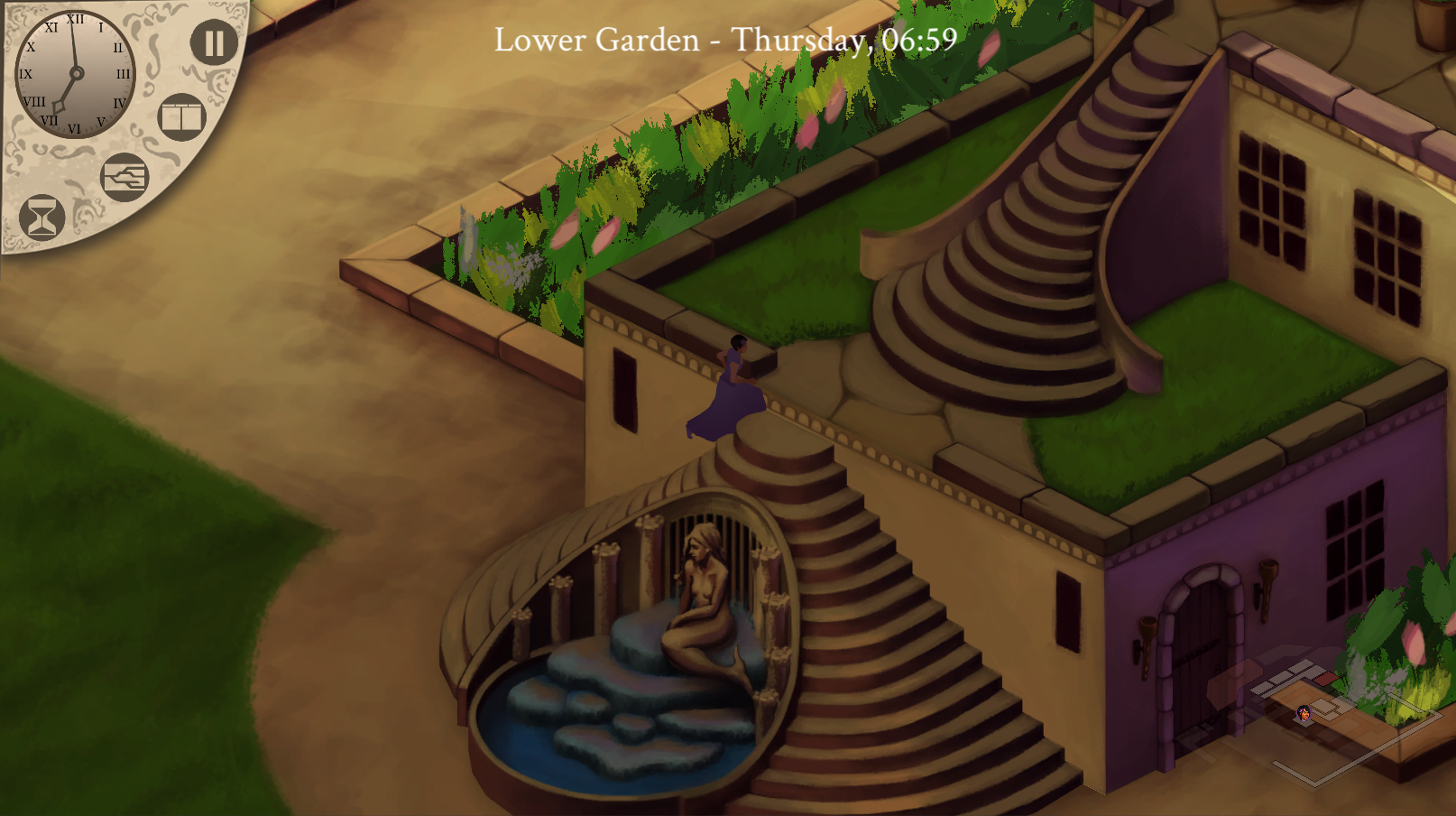In video games as well as theater, true to Hamlet’s famous line, the play is indeed the thing. But, punning aside, perhaps few game-players would consider the two forms to have much in common, especially not the musty works of Shakespeare himself.
While the muddy intersection between games and literature is firm territory for laughs—just look at “Gatsby no Monogatari,” the gloriously-fake NES adaptation of F. Scott Fitzgerald’s classic novel, featuring the famous spectacles of TJ Eckleburg as an area boss—the concept of a wholesale video game adaptation of a tragedy like Hamlet defies the imagination. But this apparent disconnect hasn’t stopped Katie Chironis and Connor Fallon of Golden Glitch, the respective writer and designer of the upcoming Elsinore, from trying to bridge this considerable gap.
Videos by VICE
“It was a contest for this game creation club we were in back in college,” says Fallon, smirking. “The theme was Shakespeare. The main question that got us started was ‘how do you do tragedy in a format that people try to win?’”
A designer at Guild Wars studio ArenaNet by day, Fallon is wiry and frantic, but in a charming way. He has a penchant for sweeping hand gestures that reflect his theatrical background, unconsciously or not.
He continues: “Katie has always been a fan of time-looping tragedies. They’re popular in Asia but not here in the US, at least they weren’t at the time. It was her idea to apply that format to Shakespeare. And that’s when we realized we had a really good idea. But it wasn’t until we graduated and all got day jobs that we decided to actually work on it as our main project.”

Header and all Elsinore screens courtesy of Golden Glitch Studios
“When people ask me to describe Elsinore, I’ll say ‘Groundhog Day meets Hamlet,’” adds Chironis. “It’s a reference almost everyone in the US understands. I found the time loop metaphor particularly adept for Elsinore because it was a good framework to convey tragedy in an interactive way. Tragedy is an interesting beast to tackle, especially in games.”
Earlier, I sat in a rickety wooden chair at IndieCade 2016 to take a look at a recent build of Golden Glitch’s ambitious title. Beneath the game’s impressionistic visual style—which resembles a stone splashing into Monet’s famous water lily ponds—lies the whirling gears of a familiar clock tower.
A clock tower that, true to Fallon’s words, has suffered its own tragic destruction countless times. It’s fitting: that monument serves as both the best-known example of a video game time-loop and the unapologetic inspiration for Elsinore’s temporal machinations. I’m referring to 2000’s Legend of Zelda: Majora’s Mask, perhaps the most divisive entry in one of gaming’s most beloved franchises.
Unlike the other games in the Zelda cycle, where protagonist Link is an established crusader of out to vanquish evil forces that harbor doom and destruction, in Majora’s Mask he plays the role of the interloper, working against the clock to right uncertain wrongs and stop an apocalypse from destroying Termina. The heroic through line remains, but the trappings are painted in darker hues, the stuff of botched marriages, incompetent politicians, and broken families. As Fallon notes, the Shakespearean comparison isn’t that far off.
“The big thing that makes Majora’s Mask so controversial, besides those themes, is the whole idea that the world moves on without you,” Fallon says. “It’s the idea that if I just wait in one place, the moon will just crash into the Earth and everyone will die. And that’s definitely one of the things we’re going for.”

Elsinore
Perhaps for this reason, Elsinore doesn’t cast you as the maddeningly-indecisive Prince of Denmark; instead, you play the role of Ophelia, Hamlet’s one-time paramour. She experiences a nightmare vision of the events of the play, and resolves to put a wrench in the works before most of the residents of the namesake castle die grisly, pointless deaths.
This forms the core difficulty of the game: By default, the age-old story rolls on, a sea of blood flowing in its wake. By intervening with the right character at the right time, Ophelia can alter the events in the world, however marginally. But unlike Majora’s Mask, which ends with Link’s unmarred triumph over the mask itself, the tragic undertones of Elsinore cannot be so easily defeated.
“The theme that we’re going for is that you can improve some things, but everything good comes with a cost,” says Fallon, his hand movements growing more emphatic. “You’re sacrificing something to get something else. And different players might prioritize different things accordingly. That’s where we get away from the Majora comparison. Games have a tendency to draw from the Star Wars school of storytelling—hero’s journey and all that. That’s not what Hamlet is about.”
“Designers are often fundamentally chasing the ‘power fantasy,’” says Chironis. “How can we make you feel like a hero and shower you with prizes and special effects? In making a Hamlet video game, a lot of people have asked us why we didn’t make Hamlet the main character. The simple answer is that I found that idea pretty boring. Power fantasies have their place, and I have enjoyed designing those games when it was a part of my day job—but it’s much more interesting to make players feel underpowered and outmatched, then to see how they behave.”
Of course, adapting such a seminal work of the stage brings its own set of difficulties. For one, certain aspects of the play, such as Horatio’s true vocation or the intricacies of the Ophelia/Hamlet relationship, remain ambiguous—both by design and by sheer chance—and the very act of translating the work into another medium necessitates and crystallizes one’s interpretation of these events.

Elsinore
By making this game, Golden Glitch thus places itself in the arena of the Shakespearean scholars who have vigorously debated these seemingly inconsequential details for almost half a millennia. To hear Fallon tell it, this pressure is palpable, but not entirely unwanted; after all, to him, that’s what makes the play such good source material. With centuries of critics picking apart text and subtext, the possibilities offered by the story space are far more vast than its traditional trappings first lead you to believe.
But, to Fallon, Elsinore also offers a tremendous opportunity to build the world out a bit. Characters like Hamlet’s paternal and maternal grandparents might not figure into Shakespeare’s original text, but removed from the temporal constraints of the theatre, such development can add texture and depth to Golden Glitch’s vision of the work.
“We read Hamlet like eighty times,” says Fallon, laughing. “Our format helps a lot in that we don’t have to change a lot of core stuff, we just have to add. When you’re really trying to get to know these characters, you add complexity to them. It would actually be harder, I think, to do what Tom Stoppard did with Rosencrantz and Guildenstern are Dead, to write a new book with one timeline, and have to decide what scenes matter. When it’s a game, the player makes those decisions, and some of that pressure is relieved.”
Golden Glitch’s game might not be the first stab at a Shakespearean video game, but it certainly feels like the most earnest—a spirited effort to bring the magic of the Bard to video game form. And while the tension of adaptation is palpable for the team, Fallon welcomes it.
“The best way it was described to me was that the player is an improv actor and everybody else is given assigned roles. When it comes from adaptations from play to film, you have to cut scenes. Everything is interpreted for you by the director, and they’re canonizing that with the image. With Elsinore, just like in the theater, you get to see it played as many ways as we could think of. And there’s a real joy in that, and I can’t wait for people to experience it for themselves.”
More
From VICE
-

Screenshot: The Game Awards -

Screenshot: Rockstar Games -

Screenshots: Electronic Arts -

Screenshot: Shaun Cichacki
